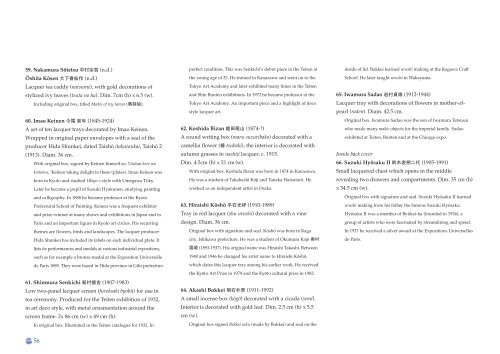Hotei Japanese Prints catalog autumn 2014
Samples of Japanese beauty Prints, paintings and design from three centuries.
Samples of Japanese beauty Prints, paintings and design from three centuries.
You also want an ePaper? Increase the reach of your titles
YUMPU automatically turns print PDFs into web optimized ePapers that Google loves.
59. Nakamura Sôtetsu 中 村 宗 哲 (n.d.)<br />
Ôshita Kôsen 大 下 香 仙 作 (n.d.)<br />
Lacquer tea caddy (natsume), with gold decorations of<br />
stylized ivy leaves (tsuta no ha). Dim. 7cm (h) x 6.5 (w).<br />
Including original box, titled Makie of ivy leaves ( 蔦 蒔 絵 ).<br />
60. Imao Keinen 今 尾 景 年 (1845-1924)<br />
A set of ten lacquer trays decorated by Imao Keinen.<br />
Wrapped in original paper envelopes with a seal of the<br />
producer Hida Shunkei, dated Taishô itakurankai, Taishô 2<br />
(1913). Diam. 36 cm.<br />
With original box, signed by Keinen himself as: Yôsôsai kore wo<br />
konomu, ‘Keinen taking delight in these (plates). Imao Keinen was<br />
born in Kyoto and studied Ukiyo-e style with Umegawa Tôky.<br />
Later he became a pupil of Suzuki Hyakunen, studying painting<br />
and calligraphy. In 1888 he became professor at the Kyoto<br />
Prefectural School of Painting. Keinen was a frequent exhibitor<br />
and prize-winner at many shows and exhibitions in Japan and in<br />
Paris and an important figure in Kyoto art circles. His recurring<br />
themes are flowers, birds and landscapes. The lacquer producer<br />
Hida Shunkei has included its labels on each individual plate. It<br />
lists its performances and medals at various industrial expositions,<br />
such as for example a bronze medal at the Exposition Universelle<br />
de Paris 1889. They were based in Hida province in Gifu prefecture.<br />
61. Shinmura Senkichi 新 村 撰 吉 (1907-1983)<br />
Low two-panel lacquer screen (furoksaki byobû) for use in<br />
tea ceremony. Produced for the Teiten exhibition of 1932,<br />
in art deco style, with metal ornamentation around the<br />
screen frame. 2x 86 cm (w) x 49 cm (h).<br />
In original box. Illustrated in the Teiten <strong>catalog</strong>ue for 1932. In<br />
perfect condition. This was Senkichi’s debut piece in the Teiten at<br />
the young age of 25. He trained in Kanazawa and went on to the<br />
Tokyo Art Academy and later exhibited many times in the Teiten<br />
and Shin Bunten exhibitions. In 1972 he became professor at the<br />
Tokyo Art Academy. An important piece and a highlight of deco<br />
style lacquer art.<br />
62. Koshida Bizan 越 田 尾 山 (1874-?)<br />
A round writing box (maru suzuribako) decorated with a<br />
camellia flower ( 椿 tsubaki), the interior is decorated with<br />
<strong>autumn</strong> grasses in nashiji lacquer, c. 1915.<br />
Dim. 4.5cm (h) x 21 cm (w).<br />
With original box. Koshida Bizan was born in 1874 in Kanazawa.<br />
He was a student of Takahashi Kôji and Tanaka Hatsutarô. He<br />
worked as an independent artist in Osaka.<br />
63. Hiraishi Kôshô 平 石 光 祥 (1910-1989)<br />
Tray in red lacquer (shu urushi) decorated with a vine<br />
design. Diam. 36 cm.<br />
Original box with signature and seal. Kôshô was born in Kaga<br />
city, Ishikawa prefecture. He was a student of Okumura Kajô 奥 村<br />
霞 城 (1893-1937). His original name was Hiraishi Takashi. Between<br />
1940 and 1946 he changed his artist name to Hiraishi Kôshô,<br />
which dates this lacquer tray among his earlier work. He received<br />
the Kyôto Art Prize in 1979 and the Kyôto cultural prize in 1982.<br />
64. Akashi Bokkei 明 石 朴 景 (1911-1992)<br />
A small incense box (kôgô) decorated with a cicada (semi).<br />
Interior is decorated with gold leaf. Dim. 2.5 cm (h) x 5.5<br />
cm (w).<br />
Original box signed Bokkei saku (made by Bokkei) and seal on the<br />
inside of lid. Bokkei learned urushi making at the Kagawa Craft<br />
School. He later taught urushi in Wakayama.<br />
65. Iwamura Sadao 岩 村 貞 雄 (1912-1944)<br />
Lacquer tray with decorations of flowers in mother-ofpearl<br />
(raden). Diam. 42.5 cm.<br />
Original box. Iwamura Sadao was the son of Iwamura Tetsusai<br />
who made many makie objects for the imperial family. Sadao<br />
exhibited at Teiten, Bunten and at the Chicago expo.<br />
Inside back cover<br />
66. Suzuki Hyôsaku II 鈴 木 表 朔 二 代 (1905-1991)<br />
Small lacquered chest which opens in the middle<br />
revealing two drawers and compartments. Dim. 35 cm (h)<br />
x 34.5 cm (w).<br />
Original box with signature and seal. Suzuki Hyôsaku II learned<br />
urushi making from his father the famous Suzuki Hyôsaku.<br />
Hyôsaku II was a member of Ryûkei-ha (founded in 1934), a<br />
group of artists who were fascinated by streamlining and speed.<br />
In 1937 he received a silver award at the Expositions Universelles<br />
de Paris.<br />
56


